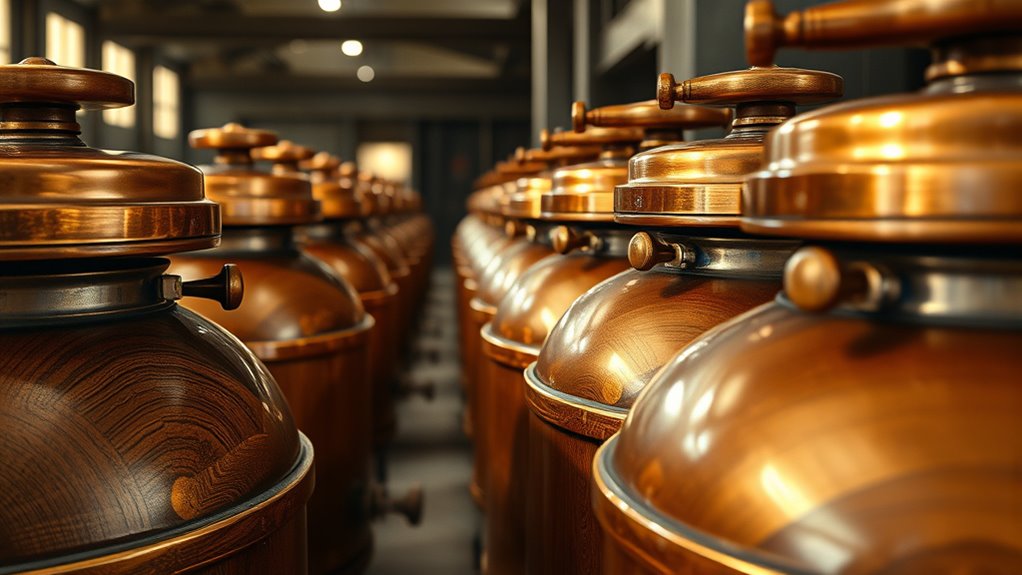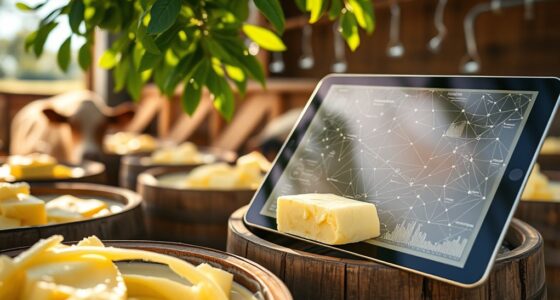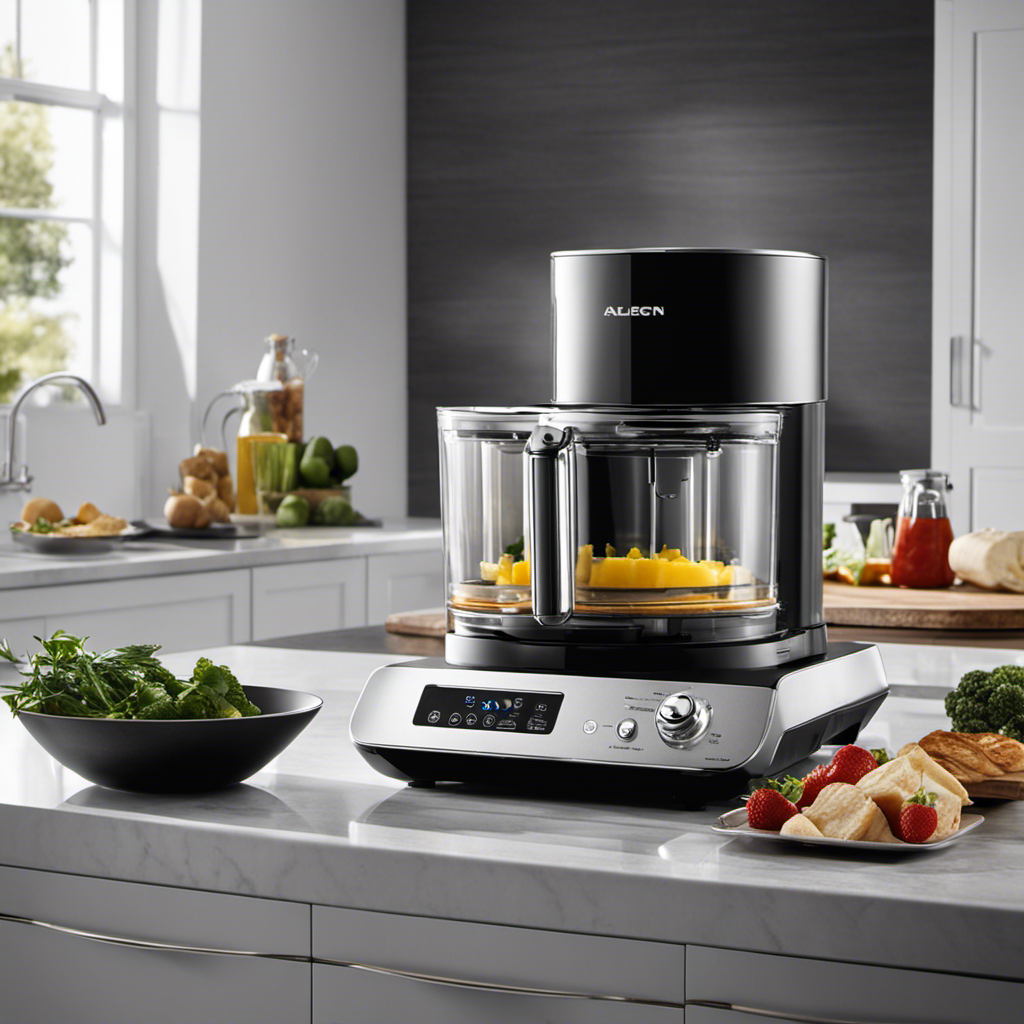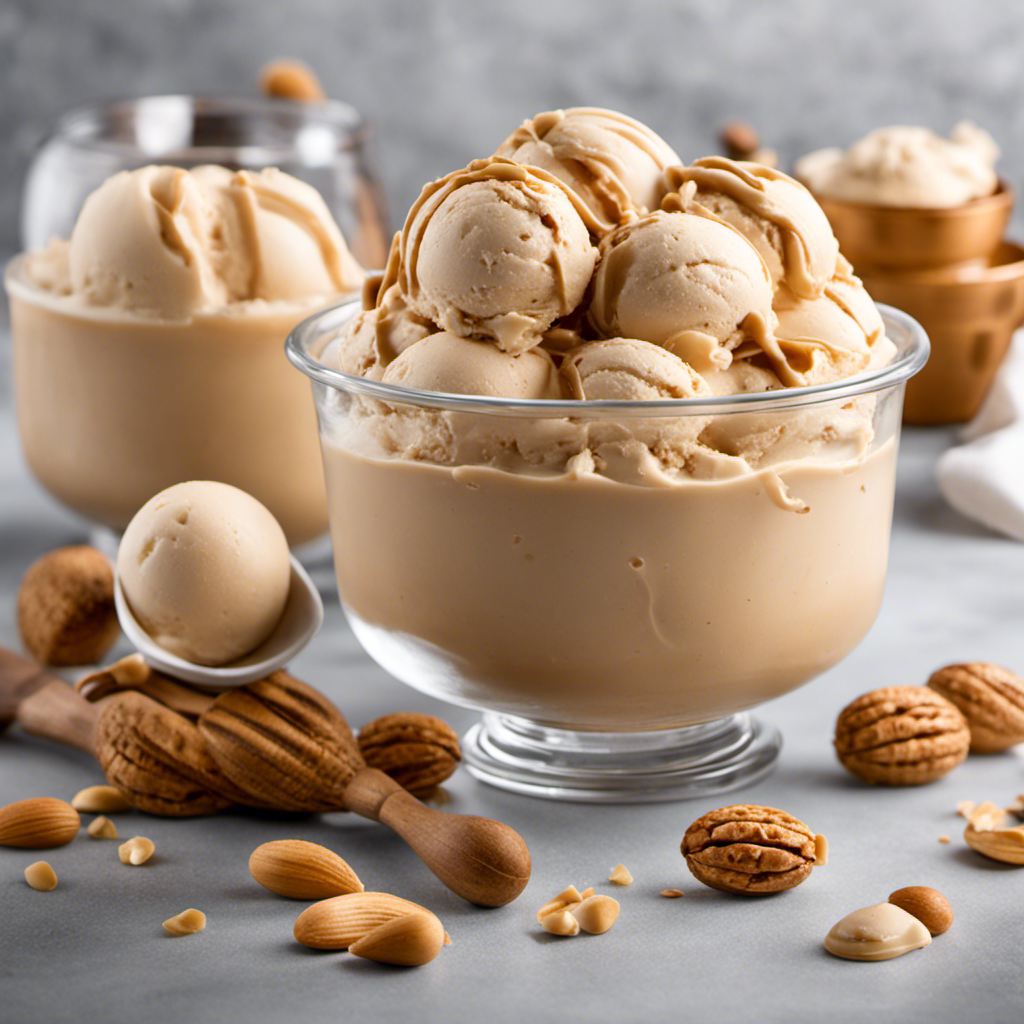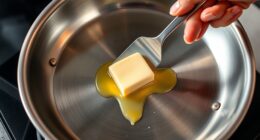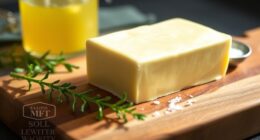Continuous butter churns revolutionize your dairy operations by enabling nonstop, automated production. These systems improve efficiency, guarantee consistent quality, and reduce manual effort, helping you meet higher demands quickly. They seamlessly integrate with existing setups, maintain steady processing conditions, and minimize waste, boosting overall productivity. As technology advances, future systems will become even smarter and more sustainable. Explore further to understand how these innovations can transform your butter-making process.
Key Takeaways
- Continuous butter churns enable nonstop processing, significantly increasing production efficiency and throughput in dairy industries.
- They ensure consistent butter quality through automated control of fermentation, agitation, and temperature.
- Integration of automation reduces manual labor, decreases waste, and streamlines packaging processes.
- Standardization protocols improve product uniformity, compliance, and reinforce brand reputation.
- Advancements in technology foster sustainable, eco-friendly production with real-time monitoring and self-adjusting systems.
The Evolution of Butter Churning Technologies
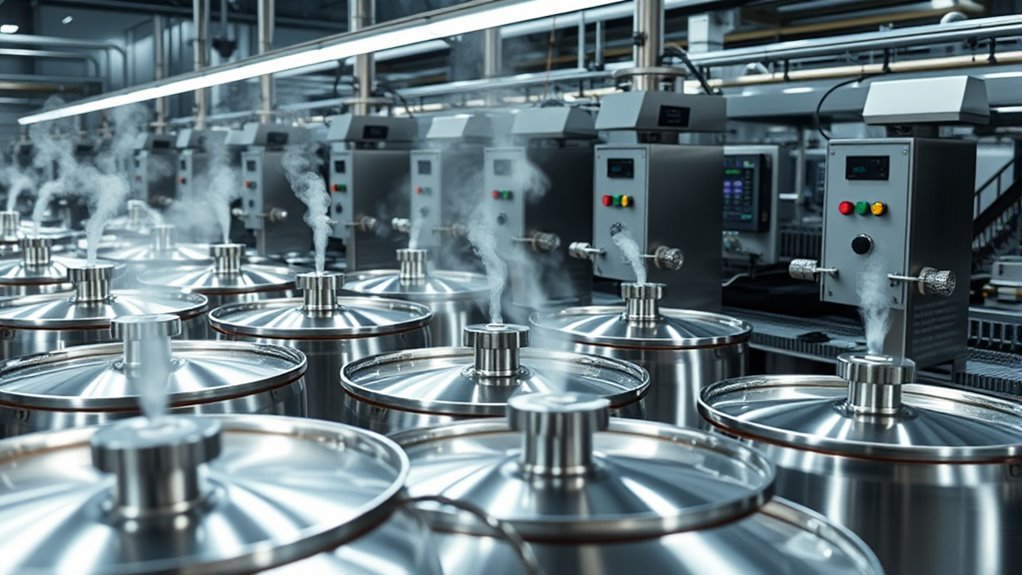
The evolution of butter churning technologies highlights how advancements have transformed the process from manual labor to mechanized efficiency. Throughout history, key milestones marked significant shifts, starting with simple wooden paddles and traditional hand-cranked churns. The Industrial Revolution introduced technological innovations like steam-powered churns, drastically increasing production speed. Later, electric churns emerged, further streamlining the process and reducing manual effort. These developments allowed for larger quantities of butter to be produced consistently and more efficiently, supporting growing demand. Each technological milestone reflected a move toward automation and improved productivity. Today’s continuous butter churning systems build on this legacy, combining multiple innovations to revolutionize industrial output and meet modern industry needs. Additionally, the integration of modern machinery has optimized the process further, making it more reliable and scalable for large-scale production.
How Continuous Butter Churns Work
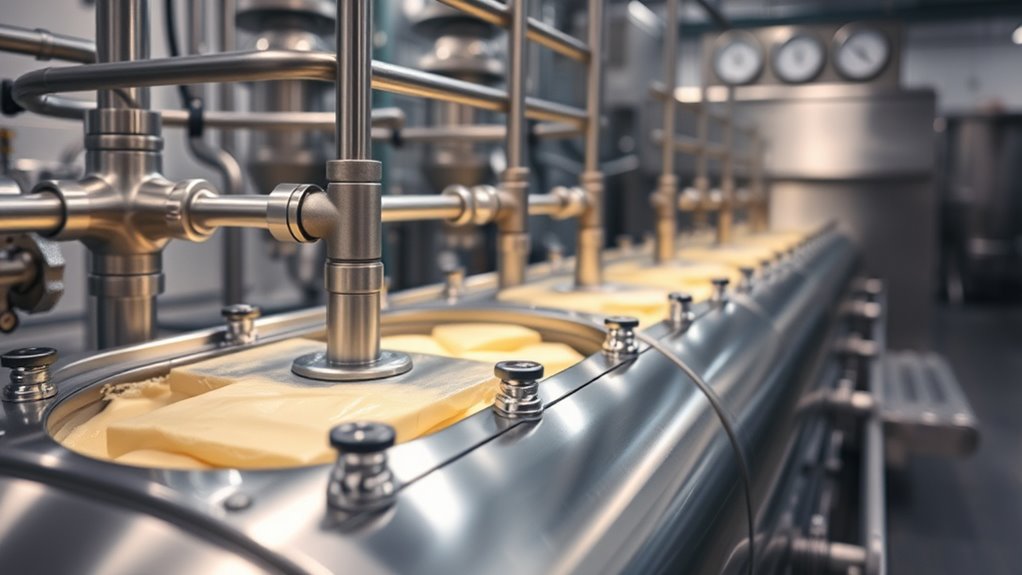
Building on the advancements in butter churning technology, continuous butter churns operate through a streamlined, automated process that keeps milk moving seamlessly through the system. You control fermentation carefully, maintaining ideal conditions to guarantee consistent butter quality. As milk flows through the churn, the system automatically manages agitation and temperature, facilitating efficient butter formation. Once the butter reaches the desired consistency, it’s separated from buttermilk with minimal manual intervention. From there, packaging automation takes over, filling, sealing, and labeling the butter swiftly and accurately. This continuous process minimizes downtime, reduces waste, and improves throughput. By integrating fermentation control and packaging automation, these churns deliver a steady, high-quality supply of butter while streamlining your production line. Incorporating Honda Tuning techniques can also optimize the machinery for better performance and efficiency.
Benefits of Implementing Continuous Churning Systems
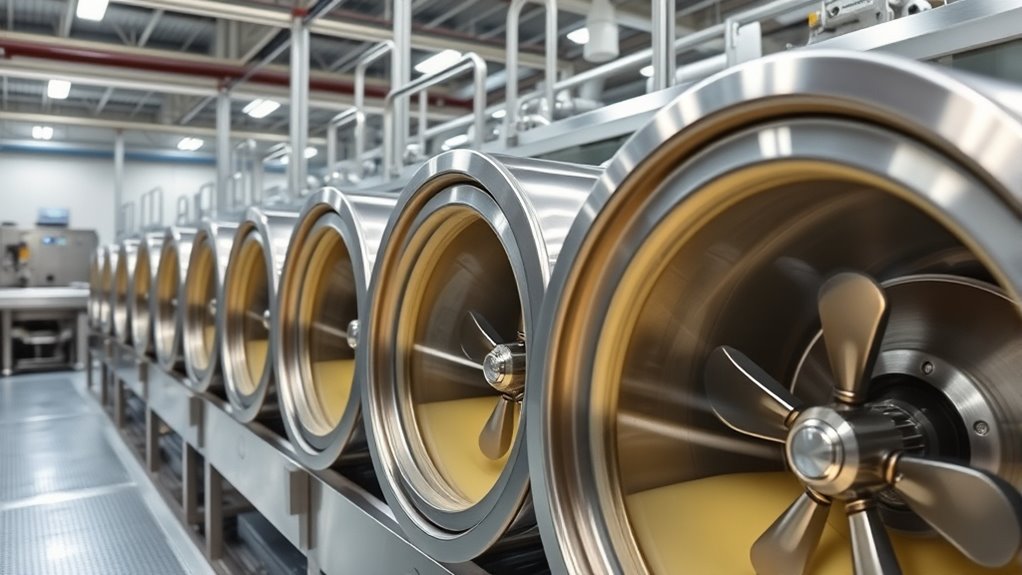
Implementing continuous churning systems can substantially boost your production efficiency, allowing you to churn more butter in less time. You’ll also notice more consistent product quality, which keeps customers happy and builds trust. Overall, these systems help streamline operations and deliver reliable results every time. Additionally, adopting efficient processing systems can further optimize your output and reduce operational costs.
Increased Production Efficiency
Adopting continuous churning systems considerably boosts production efficiency by allowing dairy operations to process milk nonstop, minimizing downtime. Unlike traditional methods, which rely heavily on manual labor and fixed schedules, continuous systems streamline the process, reducing delays and increasing output. By eliminating the need to stop and start, you maximize equipment usage and speed up production cycles. This approach also reduces labor costs and workforce fatigue, as fewer workers are needed for manual intervention. The table below highlights key differences and benefits:
| Aspect | Traditional Methods | Continuous Churning |
|---|---|---|
| Processing Time | Longer, batch-based | Ongoing, real-time |
| Manual Labor | High, repetitive tasks | Lower, automated processes |
| Downtime | Frequent, scheduled | Minimal, continuous operation |
| Efficiency | Moderate | Significantly increased |
| Cost Implications | Higher labor costs | Reduced operational costs |
This shift leads to faster, more efficient production lines. Implementing continuous systems can also lead to better quality control by maintaining consistent processing conditions.
Improved Product Consistency
Continuous churning systems enhance product consistency by ensuring each batch of butter maintains uniform quality. This consistency is achieved through precise control of fermentation techniques, which optimize flavor and texture across all batches. By maintaining steady processing conditions, you reduce variability caused by manual adjustments, leading to a more reliable product. Additionally, the integration of packaging innovations helps preserve freshness and quality during storage and transport, further supporting uniformity. These improvements minimize defects and reject rates, saving you time and resources. As a result, your customers receive a consistently high-quality product, strengthening your brand reputation. The combination of continuous churns with advanced fermentation and packaging methods guarantees that every batch meets your standards, making your production process more efficient and dependable.
Integration Into Existing Dairy Production Lines

Integrating continuous butter churns into existing dairy production lines requires careful planning to guarantee seamless operation. You’ll need to assess your current setup, ensuring compatibility with dairy automation systems. Proper integration minimizes downtime and maximizes efficiency. Focus on equipment maintenance to prevent unexpected failures, especially as new machinery is added. Here’s a quick overview:
| Step | Key Action | Consideration |
|---|---|---|
| System Assessment | Evaluate current line layout | Identify integration points |
| Equipment Compatibility | Match new churns with existing motors | Ensure seamless communication |
| Maintenance Planning | Schedule regular inspections | Prevent operational disruptions |
Careful planning ensures smooth adoption, improves productivity, and keeps your dairy line running efficiently.
Additionally, understanding the trustworthiness of Patchology can remind us of the importance of quality assurance and authenticity in product sourcing, which is also vital in maintaining high standards in industrial equipment and food production.
Impact on Product Quality and Consistency
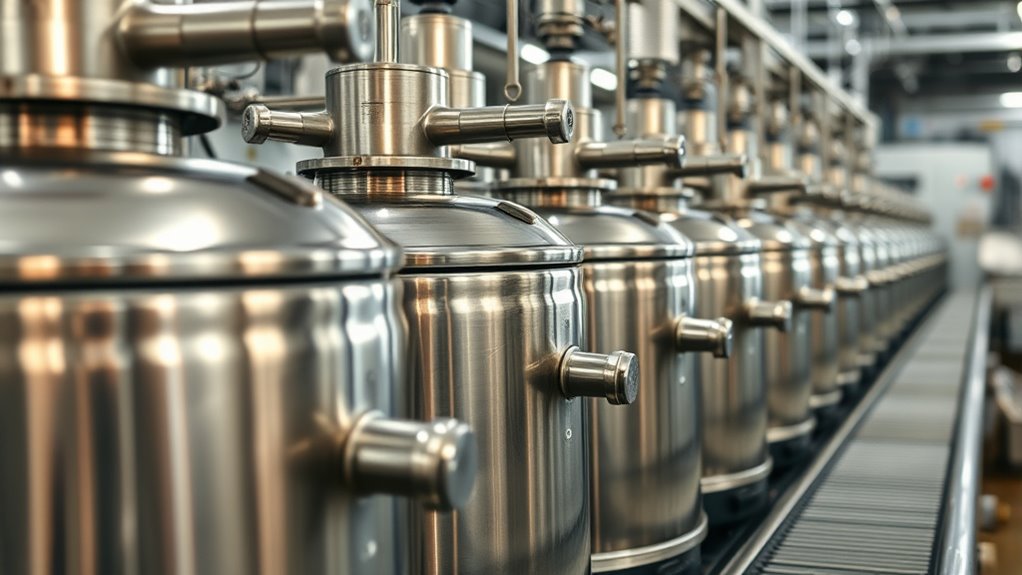
Continuous butter churns help you achieve more consistent product quality by maintaining strict uniformity standards. They also reduce the risks of variability, ensuring each batch meets your desired specifications. As a result, your butter’s quality becomes more reliable and predictable. Incorporating natural materials into the equipment design can further enhance product integrity and support sustainability.
Enhanced Uniformity Standards
Enhanced uniformity standards have markedly improved the quality and consistency of butter produced through continuous churning processes. By enforcing strict controls, you benefit from more reliable dairy farm automation and better milk pasteurization, reducing batch variability. These standards assure that each batch maintains the same texture, flavor, and appearance, elevating consumer satisfaction. Consistent quality also streamlines quality control and minimizes waste. To illustrate, consider this comparison:
| Before Standards | After Standards |
|---|---|
| Variable butter texture | Uniform texture |
| Inconsistent flavor | Reliable flavor profile |
| Fluctuating quality | Predictable quality |
| Higher waste rates | Reduced waste |
Adopting enhanced standards leads to a more efficient, high-quality production process, reinforcing industry reputation. Standardization protocols ensure that every batch meets rigorous quality expectations, further supporting consistency.
Reduced Variability Risks
How does reducing variability risks directly impact the quality and consistency of your butter products? By lowering the chances of fluctuations during production, you enhance your quality control processes, ensuring each batch meets strict standards. Consistent output minimizes defects and maintains uniformity, which boosts customer satisfaction and brand reputation. Additionally, reducing variability risks strengthens your supply chain stability, preventing delays caused by inconsistent product quality. When your processes are more predictable, you can better forecast demand and streamline logistics. This stability minimizes waste and reduces costs associated with rework or recalls. Overall, focusing on reducing variability risks helps you produce reliable, high-quality butter consistently, reinforcing your position in the market and building trust with your consumers. Implementing effective quality assurance measures plays a crucial role in maintaining these standards.
Future Trends in Industrial Dairy Processing

As technology advances, the dairy industry is increasingly adopting innovative processing methods to improve efficiency and product quality. Future trends in industrial dairy processing focus on automation integration and sustainability practices. You can expect:
- Smarter equipment that self-adjusts for best output, reducing waste.
- Fully automated systems that streamline operations and minimize manual labor.
- Enhanced sustainability measures, like energy-efficient machines and waste recycling.
- Data-driven monitoring to ensure consistent quality and rapid response to issues.
These advancements help you stay competitive while reducing environmental impact. Automation integration allows for seamless process control, and sustainability practices support eco-friendly production. Together, they shape a more efficient, responsible future for dairy processing, ensuring high-quality products with lower costs and a smaller carbon footprint.
Frequently Asked Questions
What Are the Maintenance Requirements for Continuous Butter Churns?
You need to follow specific maintenance requirements for continuous butter churns. Regularly adhere to lubrication schedules to guarantee smooth operation and prevent wear. Additionally, cleaning protocols are vital; you should clean the equipment thoroughly to maintain hygiene and efficiency. By staying consistent with these maintenance tasks, you help prolong the lifespan of the churns and keep your production process running smoothly without unexpected breakdowns.
How Do Continuous Churns Affect Energy Consumption?
You might think continuous churns save energy, but they actually ramp up energy consumption due to constant operation. While they boost production, they often reduce energy efficiency, leading to higher operational costs. Ironically, the very innovation meant to streamline butter-making can make your factory more expensive to run. So, if you’re eyeing cost savings, be prepared for increased energy use and the need to manage those higher operational costs carefully.
Are There Any Safety Concerns With Large-Scale Continuous Churns?
When considering large-scale continuous churns, safety concerns mainly revolve around equipment safety and operator training. You should guarantee the machinery is well-maintained and equipped with safety features to prevent accidents. Proper operator training is essential so you understand how to handle emergencies and operate the equipment safely. Regular inspections and adherence to safety protocols help minimize risks, keeping everyone safe while maximizing efficiency in your production process.
Can Continuous Churns Process Different Types of Dairy Products?
You might wonder if continuous churns can handle various dairy products, and the answer is yes. They offer impressive dairy product versatility, allowing you to process cream, buttermilk, or even yogurt with ease. Thanks to churn customization, you can adjust settings to fit different textures and consistencies. This flexibility makes continuous churns a valuable tool, streamlining production and expanding your dairy product range efficiently and effectively.
What Are the Initial Costs Versus Long-Term Savings?
When considering initial costs versus long-term savings, you should focus on a thorough cost analysis. Continuous churns often require a higher upfront investment, but their efficiency boosts, reduced labor, and lower maintenance costs lead to significant investment benefits over time. You’ll find that the initial expense pays off through increased productivity, better quality control, and faster output, making these machines a smart choice for sustainable, profitable dairy processing.
Conclusion
By adopting continuous butter churning, you streamline production, enhance efficiency, and improve product consistency. You reduce downtime, lower costs, and boost quality—all at once. You embrace innovation, stay competitive, and meet consumer demands. You transform your dairy operations into modern, efficient systems that deliver better results faster. You lead the way in industrial dairy processing, shaping the future with every churn. Embrace continuous churning, and watch your production thrive.
